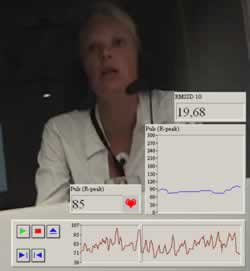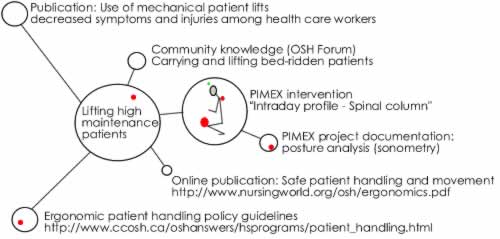 |
|
|
 |

 |
 |
 |
|
Integrated Learning of Work-Related Strains and Exposures in Health Care and Nursing Schools
|
|
| | |
|
 Integriertes Lernen über arbeitsbezogene Belastungen und Beanspruchungen in Schulen der Gesundheits- und Krankenpflege (deutsche Version) Integriertes Lernen über arbeitsbezogene Belastungen und Beanspruchungen in Schulen der Gesundheits- und Krankenpflege (deutsche Version)
The vision of a concept for integrated learning of work-related strains and exposures is to show a way for implementing a learning and knowledge space in health care and nursing schools. Following a constructivist approach we focus on the application of components and strategies that support teaching and learning in the educational system of community health concerning health care in general as well as strains and exposures in particular. Our concept of integrated learning presents an innovative approach in order to organize the elements of health promotion within the health care and nursing education and design them teach- and learnable.
Health hazards in the health care and nursing profession
- Irregular working time (night work, weekend duties)
- Aggravating working conditions (pressure of time, staff shortage)
- Psychological strains (in connection with the care for critically ill and dying patients)
- Physical work load (activities in awkward positions, prolonged standing, lifting loads)
-> work dissatisfaction, high labor turnover rates
Integrated learning
- Combining traditional and approved didactic methods with electronic tools (in conformity with blended learning)
- A moderated peer-to-peer structure that enables an active debate about teaching and learning between trainers and students
- Information technology that supports the development of learning and knowledge spaces and enables a lifelong learning process
- Tools and methods that facilitate the self dependent generation and structuring of knowledge
Knowledge and eLearning environment
Following a constructivist learning theory and teaching method the students apply tools and techniques in order to develop the knowledge structures or enhance existing structures, and assemble the e-learning units. Students combine personal experiences, online publications, statistics, general guidelines and best practices with community knowledge and measuring data from PIMEX observations. The teacher regularly assesses the knowledge the students have gained to ensure that the students perceptions of the new knowledge are what the teacher had intended. The approach is considered as teacher-supported learning that is initiated and directed by the learners who build upon knowledge that they already possess. The students are also responsible for the utilitzation of the new knowledge structures by other students (peer-to-peer process).

The PIMEX (Picture-Mix-Exposure) method
The PIMEX method aims at visualizing workplace hazards and provides support for minimizing work-related strains and exposures. A work sequence is filmed by a video camera and simultaneously, information about occurring hazards as well as medical data is recorded via a direct-reading instrument. The signal from the instrument is superimposed to the recording from the video camera to produce a video film which continuously shows the subject at work and how exposure varies. By displaying the working activity in relation to the measured expositions and the physiological data, interrelations between a certain work sequence and prevalent hazards as well as specific strains can easily be recognized. PIMEX is also intended to serve as an aid in the evaluation of various measures for reducing the exposure and in connection with the training of personnel performing work involving exposure.
Visualization of workplace hazards with the PIMEX method| Visualization | PIMEX makes workplace hazards visible |
| Analyses | PIMEX offers opportunities for analyzing reasons of exposures |
| Optimization | Improvement of working conditions and design of adequate working processes |
| Participation | Participation with PIMEX is the basis for a new prevention culture |
| Knowledge production | PIMEX is a powerful method to develop knowledge |
Applications
Analyzing hazards in health care using PIMEX
- Physical strains
Exposures pertaining to the musculoskeletal system (e.g. spinal column) and the supporting apparatus using sonometry (ultrasonic distance measurement), or examination of physiological information (e.g. heart rate, heart rate variability, respiration)
- Hazardous substances
Anesthetic gas in operating rooms and aerosols (disinfection sprays, etc.)
- Thermic comfort
Physical parameters related to the performance of heating and ventilation such as temperature, ambient air flow and humidity
- Lighting
- Dust and particulate matter
- Noise

PIMEX visualization of heart rate and heart rate variability (during night shift)
Knowledge structures
Knowledge structures are visualized using a simple graphical user interface. Starting from the center of the knowledge structure (topic) associated information - such as contributions by students, publications, interpreted data from PIMEX observations, etc. - is connected by means of self-describing relations. The knowledge structures represent specific health care and nursing topics and provide the content for the eLearning units.
Example: Lifting high maintenance patients

The pilot study was presented at the ICL 2005 (Villach/Austria, September 2005) and at the HPH-Arbeitstagung (Kantonsspital Baden/Switzerland, November 2005).
|
|
|
|
|
 |
|
|